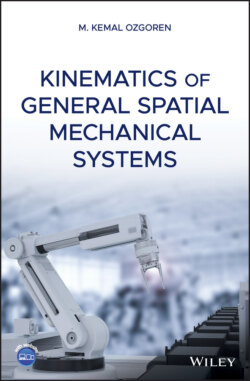Читать книгу Kinematics of General Spatial Mechanical Systems - M. Kemal Ozgoren - Страница 78
3.9.5 Mathematical Properties of the Homogeneous Transformation Matrices
Оглавление1 (a) Determinant of an HTM
Referring to Eq. (3.190), it can be shown that
(3.195)
1 (b) Inverse of an HTM
Equation (3.191) can be written in the following two ways: first by interchanging and ; and then by inverting .
(3.196)
(3.197)
Equations (3.196) and (3.197) imply that the inverse of can be taken as follows:
(3.198)
1 (c) Decomposition of an HTM
The overall displacement of with respect to consists of translational and rotational displacements. So, it can be described in the following two alternative ways.
(3.199)
(3.200)
According to the above descriptions, can be factorized as shown below.
1 (i) First translation and then rotation:(3.201)
2 (ii) First rotation and then translation:(3.202)
The factorizations described above suggest the following definitions of pure rotational and translational displacements and the associated homogeneous transformation matrices.
1 (d) HTM of a Pure Rotation
A pure rotational displacement of with respect to or a pure rotational displacement of with respect to can be achieved by pivoting about either of the origins A and B. In either case, the resultant HTM will be the same. That is,
(3.203)
In Eq. (3.203), and are the abbreviated symbols that stand for and .
Note that Eq. (3.203) is actually valid for any pivot point whatsoever. Therefore, the HTM of a pure rotational displacement does not actually need a subscript and thus it may be denoted even in the following simplest form.
(3.204)
Note also that Eqs. (3.203) and (3.204) verify the well‐known fact that a rotation operator is indifferent to the location of the pivot point.
1 (e) HTM of a Pure Translation
A pure translational displacement of with respect to or a pure translational displacement of with respect to can be expressed by one of the following HTM expressions, depending on the selected one of and , in which the translation vector is observed.
(3.205)
(3.206)
1 (f) Observation in a Third Different Reference Frame
In general, the point P and the reference frames and may be observed in a different reference frame . In such a case, considering that the vectors and are conveniently resolved in and , Eq. (3.175) can be written as follows:
(3.207)
The above affine relationship can be expressed in the following homogeneous form.
(3.208)
In Eq. (3.208), the coefficient matrix on the left‐hand side is the HTM of a pure rotation from to and the coefficient matrix on the right‐hand side is the HTM that expresses the overall rotation from to together with the translation from A to B as observed in . Thus, Eq. (3.208) can be written compactly as
(3.209)
In case of a pure rotation with B = A, Eq. (3.209) takes the following form that involves two pure‐rotation HTMs.
(3.210)
In case of a pure translation with b = a, Eq. (3.209) takes the following form.
(3.211)
As another point of concern, note that Eq. (3.209) can also be written as
(3.212)
In Eq. (3.212),
(3.213)
When Eqs. (3.212) and (3.193) are compared, it is seen that
(3.214)
Equation (3.214) shows how an HTM can be adapted to the selected observation frame.
